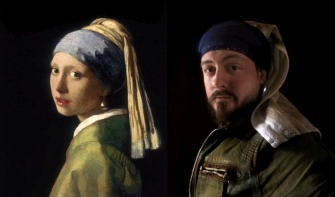Social media has changed the way the public views history, arts and culture, especially now as people stuck at home search for new forms of entertainment.
From sharing pictures of people recreating famous paintings with the hashtag #Tussenkunstenquarantine (“between art and quarantine”) to posting behind-the-scenes videos and images, museums and other cultural organizations continue to interact with the public while their doors remain closed.
Here’s a look at what virtual experiences museums and historical societies in Lackawanna and Luzerne counties are doing these days.
The Everhart Museum of Natural History, Science and Art, 1901 Mulberry St., Scranton, shared lots of content on its Facebook page, including other venues’ humorous recreations of famous paintings and its own Museum Coffee Break videos, where employees chat about their favorite pieces in the museum’s collection and share a bit of history as well. The museum also shared a “Meet the Team” photo album where the public can get to know the people working behind the scenes. Weekend challenges, meanwhile, are activities people can do at home, such as gathering and sharing home art collections, writing poetry, or creating a museum and taking a guided tour at home.
And the museum has more planned. In-person Everhart Minis and Family Workshops have been canceled, but the museum plans to host a virtual event that combines both programs for those who pre-registered for spring sessions.
“An upcoming family fun experience will be the popular Everhart Minis combined with a Family Engagement Workshop led by Museum Educator Sarah Sutton, who will lead a virtual discussion about art and art objects from the Museum’s collection, followed by a collaboration with Chef James Bolus and art illustrator Lindsay Barrett George,” said Kathy Bell, the Everhart’s director of development and marketing.
The museum’s website, everhart-museum.org, offers a growing online resource guide with activities for adults and children from several museums, and the Everhart also has posted interactive content on its Instagram account.
Pennsylvania Anthracite Heritage Museum, 22 Bald Mountain Road, Scranton, continues to highlight photos from current exhibits and its archives on its Facebook page, which Site Administrator Bode Morin said has garnered positive responses.
“The museum is putting up more content on Facebook because we feel that we have a captive audience,” he said. “And since we can’t open our doors, we are hoping to reach more people through social media.”
The museum is part of the Pennsylvania Historical Museum Commission, as is Eckley Miners’ Village Museum, 2 Eckley Main St., Weatherly. That museum has shared educational activities and historical images on its Facebook page. The public also can view artifact collections for the Anthracite Museum and Eckley at phmc.pa.gov.
Elsewhere in Scranton, Electric City Trolley Museum, 300 Cliff St., may be closed, but viewers can head to its Facebook page to check out a video about the museum by Toms Trains and Things. For more information, visit ectma.org.
Lackawanna Historical Society, 232 Monroe Ave., provides “daily diversions” by Sarah Piccini, assistant director on its Facebook page.
The society also started a Zoom lecture series, “Lackawanna Past Times,” available for replay on the Lackawanna History YouTube channel. Topics include architecture, women’s suffrage and the Civil War. A Zoom genealogy forum will take place on Wednesday, April 29, at 1 p.m. Interested participants can email lackawannahistory@gmail.com for an invitation.
The society also is asking people to share how COVID-19 has affected them through its LHS COVID-19 archive project on its website, lackawannahistory.org. There, the society also offers a local history curriculum, which traces Scranton’s past and is geared toward students in grades four through seven.
History lovers in the Wilkes-Barre area can view a virtual exhibition through the Facebook page for Luzerne County Historical Society, 49 S. Franklin St.,Wilkes-Barre. “The Best of the LCHS Photograph Collection” features photos from the facility’s archives. Although most of the collection centers on Wilkes-Barre, other areas highlighted include Kingston, Pittston, Larksville, Plymouth, Harveys Lake and Hazleton.
The public can learn about items in the society’s collection, too, in a new blog series, “FIC: Stories of Items ‘Found in Collection’” at luzernehistory.org. Mark J. Riccetti Jr., the society’s director of operations and programs, said they started the blog after getting a lot of questions about pieces in the collection before the pandemic.
“The FIC series is designed to shed a light on some of the more interesting objects in our collection, that many people may not know we have, while also explaining their individual provenance,” Riccetti said. “There is often far more to an item than meets the eye.”
Anyone with questions can email info@luzernehistory.org.
Hank Loftus, curator and program coordinator at Dorflinger Glass Museum in White Mills, said he’s seen an increase in daily foot traffic on the five-mile trail at Dorflinger-Suydam Wildlife Sanctuary, where the museum is located, even though the buildings and public restrooms on the 600-acre property are closed.
“We’ve seen families bring their kids to explore the fields, woods and ponds using educational materials they’ve printed from the internet,” Loftus said. “Meanwhile, we are working to adapt some of the materials we use for on-site visitors to use on our website.”
For more information, visit dorflinger.org or the Facebook pages for Dorflinger Glass Museum or Dorflinger-Suydam Wildlife Sanctuary.

Laura Rysz is the features copy editor and calendar editor at The Times-Tribune and runs the Talk of the Times column, which focuses on local fundraisers and other events. She also writes Chef’s Table that profiles restaurants around the region. Additionally, Laura curates events online on AccessNEPA.com. Laura is involved in the special Mother’s Day edition and curates occasional features Marry Memories and Times Travelers. She is a graduate of Haddonfield Memorial High School, New Jersey, and earned an English professional writing degree with a minor in mass communications from King’s College, Wilkes-Barre. She also earned a certificate in Social Media Marketing from Rutgers Business School. Contact: lrysz@timesshamrock.com; 570-348-9100 x5228.




